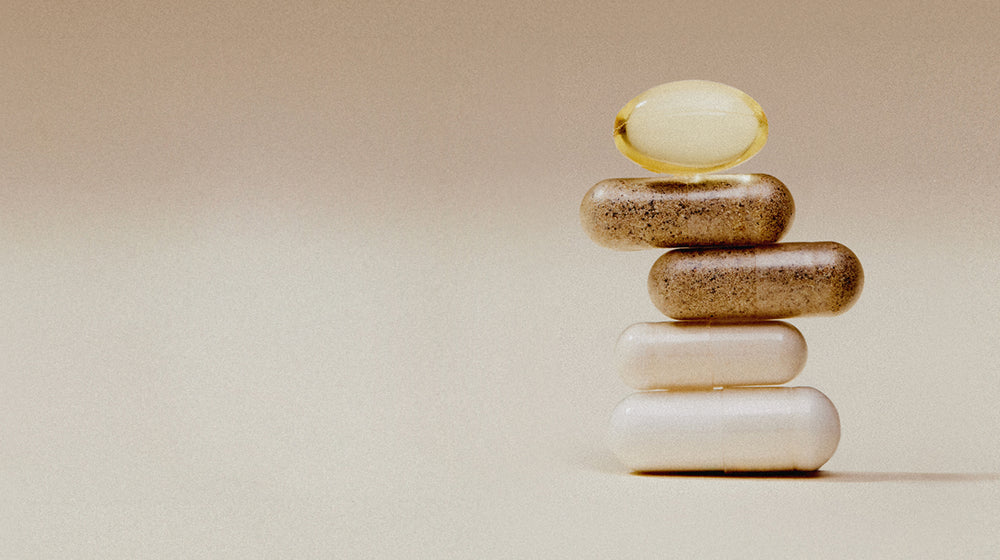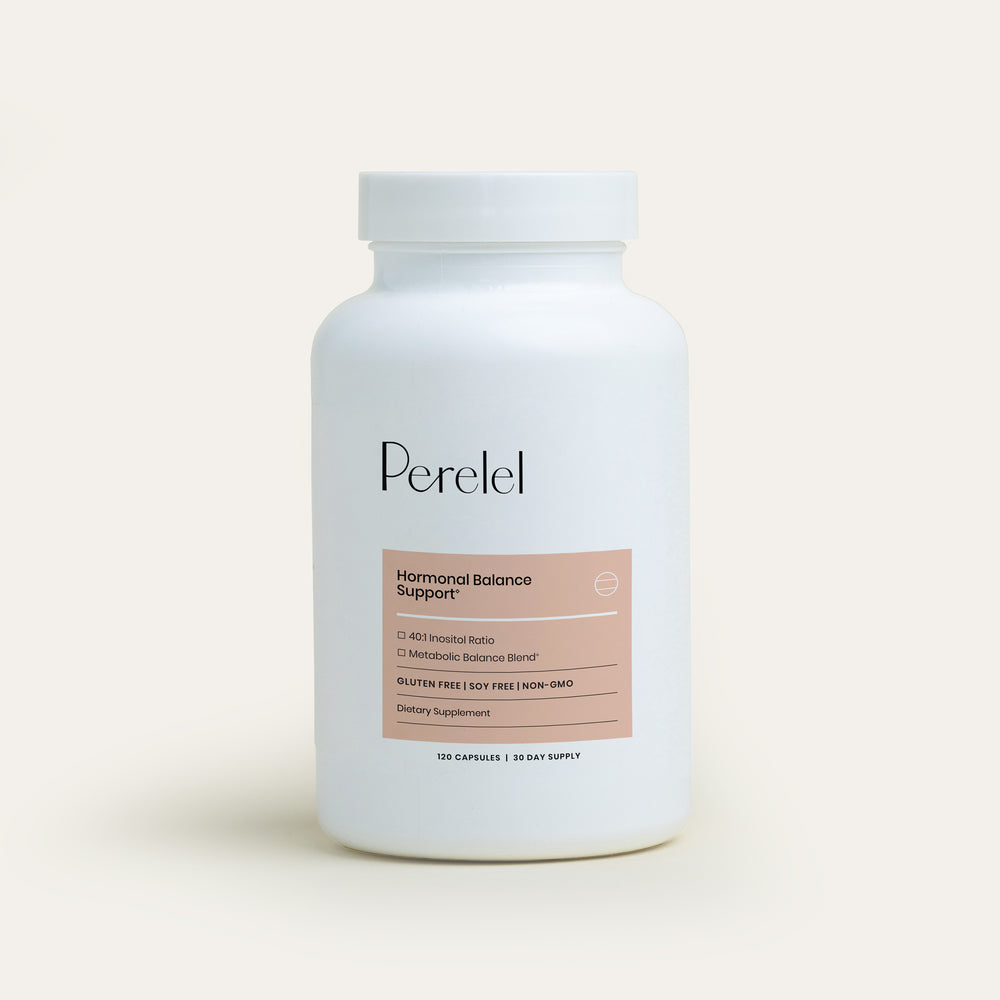Estrogen can take credit for a lot of different functions in our body: four menstrual cycles and ovulation, maintaining bone density and strength, and supporting skin elasticity and hair health, to name a few.
In other words, this particular sex hormone is probably one of the most hardworking chemicals in our bodies—playing a key role across our different reproductive life stages from menstruation to pregnancy to perimenopause and menopause. But what exactly is estrogen? How does your body make it? And how do you know if you’re not producing enough of it?
Dr. Caitlin O’Connor, ND, a naturopathic doctor and midwife on Perelel’s Panel, talks us through estrogen production, the importance of monitoring hormone levels for overall well-being, and what you can do to give low estrogen levels boost if needed.
What is estrogen?
Let’s start by breaking down the basics of what the sex hormone estrogen is. While it’s commonly referred to as the reproductive hormone as it has a role in the reproductive system, it also exists within many parts of the body’s functionality—the production of estrogen is key for women’s health in the support of positive mood and cognition, bone and cardiovascular health, and skin and hair. “Estrogen is the hormone created by tissues in the body as well as by the follicles in the ovaries,” says Dr. O’Connor. “We typically think about it as a reproductive hormone but it also has conversations with our bones and muscles. It is ubiquitous in its impact on the body.”
Shop the Article:
How do we know if our estrogen levels are low?
One of the hallmark signs of low estrogen or low estrogen levels is the absence of ovulation in the menstrual cycle. “If you’re not ovulating, you’re likely not producing much estrogen,” explains Dr. O’Connor. She advises first determining whether ovulation and menstruation is occurring (are you getting regular periods?), as low estrogen often indicates that it’s not. (Other things like PCOS, aka Polycystic Ovary Syndrome, endometriosis, or other ovarian issues might be at play here, however.) Symptoms of low estrogen typically include dysfunction in menstruation, irregular menstrual cycles or irregular periods, vaginal dryness, hot flashes, brain fog, mood swings, night sweats, sleep disturbances, fatigue, and increased pain.
If you think you might be experiencing low estrogen, talking to your doctor or healthcare provider and getting blood tests to confirm that the sex hormone is low is suggested, although Dr. O’Connor explains testing is nuanced during each menstrual cycle, with many fluctuations. “Testing is complicated because your estrogen levels change throughout the month,” says Dr. O’Connor. “If you really want to get an indication of levels, go on day three to five of your menstrual cycle. However, keep in mind there is not a lot of overall consensus of what levels are ideal or not.”
It's also important to keep in mind that estrogen levels can fluctuate, with those with lower egg quality or perimenopause sometimes experiencing varying ranges of estrogen production than usual (which will show on the blood test). It's only after menopause that estrogen levels drop significantly and remain low, and that postmenopausal women have different considerations for estrogen.
How should we be looking at estrogen levels?
Dr. O’Connor explains that estrogen levels vary significantly throughout our lives, especially during pregnancy, perimenopause and after menopause, making it a little complex to assess them. Since this sex hormone plays such an important role, she suggests dividing "low estrogen" into two categories: pathological and non-pathological.
Pathologically low estrogen occurs in individuals of reproductive age who should typically be ovulating but aren't, so the biggest thing is if you see irregularities in your menstrual cycle, that might be a sign of low estrogen which can be concerning, particularly for health conditions. “Having low estrogen in your reproductive years creates an increased risk of osteoporosis and other illnesses,” Dr. O’Connor says.
On the other hand, non-pathological low estrogen refers to dips in estrogen during normal life stages like perimenopause, where a decline in estrogen is expected as part of the aging process and it isn’t considered a pathology. Understanding these differences is essential for finding the appropriate treatment.


What are your
stage-specific needs?
Let us personalize your vitamin routine in 60 seconds.
What are some ways we can boost our estrogen levels?
“If you’re of reproductive age and not ovulating, the first step is to determine why. We examine factors like nutrition, sleep, and overall stress levels, as these can significantly impact estrogen production," she says. To address pathologically low estrogen levels, Dr. O’Connor recommends lifestyle changes and incorporating botanical medicines, such as Vitex and adrenal adaptogens like holy basil and ashwagandha, as well as methods like vaginal estrogen insertion, or hormone replacement therapy to help restore hormonal balance.
However, the approach differs for perimenopause or menopause. In these cases, Dr. O’Connor emphasizes treating the symptoms rather than the cause to make the individual as comfortable as possible. Things like acupuncture, herbs, and regular exercise can alleviate discomfort. (It's why we teamed up with leading women's health doctors to create our Peri Support Pack, designed specifically to support symptoms associated with the perimenopause transition.)
This approach also applies to postmenopause and postpartum, focusing on comfort and symptom management for postmenopausal women and mothers rather than treating it as a pathology.
“Our hormones are part of a bigger story of what is happening in the body and understanding the why—creating a toolkit and treating the cause is important. But if it’s normal or an expected occurrence as we age, we then use the toolkit to treat the symptoms,” she says.
Should you try an estrogen-boosting supplement or hormone replacement therapy?
Whether or not you need to boost your estrogen levels depends on your specific health circumstances. If you're experiencing symptoms of low estrogen, such as irregular periods, hot flashes or night sweats, bone density loss, vaginal dryness, or other health conditions, it's important to consult with a healthcare provider to rule out other possible concerns, like ovarian issues or endometrial issues. They can determine if boosting estrogen is necessary and recommend the appropriate treatment, which may include lifestyle changes, supportive supplements, or hormone replacement therapy.
Next up: Everything you want to know about perimenopause, plus how perimenopause impacts fertility.

theFolio in Your Inbox
Sign up to receive doctor-backed, stage-specific content in your inbox each week.
This article is for informational purposes only. It is not, nor is it intended to be, a substitute for professional medical advice, diagnosis, or treatment and we recommend that you always consult with your healthcare provider. To the extent that this article features the advice of physicians or medical practitioners, the views expressed are the views of the cited expert and do not necessarily represent the views of Perelel.

























